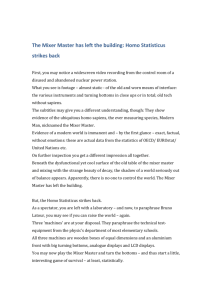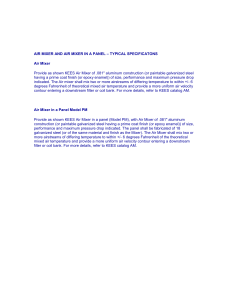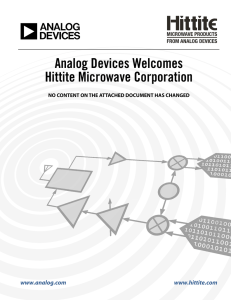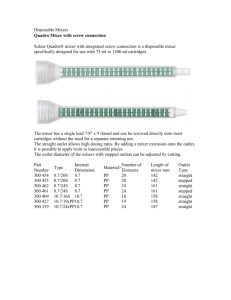Analog Devices Welcomes Hittite Microwave Corporation www.analog.com www.hittite.com
advertisement
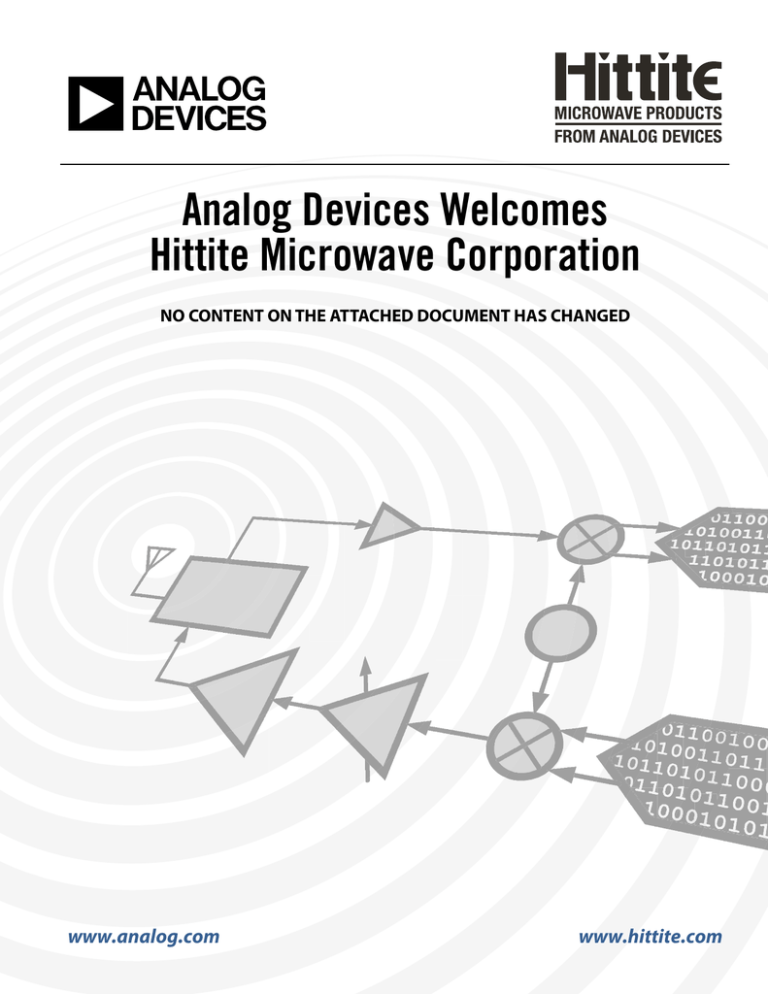
Analog Devices Welcomes Hittite Microwave Corporation NO CONTENT ON THE ATTACHED DOCUMENT HAS CHANGED www.analog.com www.hittite.com Report Title: Qualification Test Report Report Type: See Attached Date: See Attached QTR: 02016 REV: 01 PACKAGE TYPE: PLASTIC E NCAPSULATED PACKAGE FAMILY: MSOP HMC173MS8 HMC174MS8 HMC175MS8 Attenuator Switch Mixer HMC187MS8 HMC188MS8 HMC189MS8 Multiplier Multiplier Multiplier HMC190MS8 HMC194MS8 HMC199MS8 Switch Switch Switch HMC208MS8 HMC210MS8 HMC213MS8 Mixer Attenuator Mixer HMC216MS8 HMC218MS8 HMC219MS8 Mixer Mixer Mixer HMC220MS8 HMC223MS8 HMC224MS8 Mixer Switch Switch HMC230MS8 HMC251MS8 HMC272MS8 Attenuator Frequency Mixer HMC287MS8 HMC288MS8 HMC296MS8 Amplifier Attenuator Mixer HMC304MS8 HMC306MS10 HMC309MS8 Mixer Attenuator Amplifier HMC316MS8 HMC350MS8 HMC352MS8 Mixer Mixer Mixer HMC353MS8 HMC422MS8 HMC423MS8 Mixer Mixer Mixer 12 Elizabeth Drive Chelmsford, MA 01824 Phone: 978-250-3343 Fax: 978-250-3373 Boston, USA : London, UK : Munich, Germany : Seoul, Korea 1.0 Introduction 2.0 Summary of Results 3.0 Test Procedures 3.1 Package Environmental Tests 3.1.1 Initial Characteristics 3.1.2 Temperature Cycling 3.1.3 Final Characteristics 3.1.4 Autoclave 3.1.5 Final Characteristics 3.2 Package Mechanical Tests 3.2.1 Lead Coplanarity 3.2.2 Physical Dimensions 3.2.3 Resistance to Solvents 3.2.4 Solderability 1.0 Introduction This qualification procedure was designed to satisfy the package reliability requirements for plastic MSOP 8 and 10 lead surface mount packages. The testing was designed to simulate the worst-case environments the product may experience during assembly, test and life in the end user application. The device was electrically tested to the appropriate catalog specifications. The HMC174MS8 was selected to qualify the 8 and 10 lead MSOP package family. 1.1 General Description The MSOP package uses a copper lead frame. The lead frame is spot plated with silver to enable gold wire bonding. The MMIC device is epoxy attached to the paddle. The MMIC contains gold bond pads. The interconnection is performed using 1 mil gold ball bonds. The part is encapsulated using Sumitomo EME 6300 or equivalent encapsulating compound. The leads are finished with 85/15 SnPb. The HMC174MS8 is a low-cost SPDT switch in an 8- lead MSOP package for use in transmit-receive applications which require very low distortion at high signal power levels. The device can control signals from DC to 3.0 GHz and is especially suited for 900 MHz, 1.8 - 2.2 GHz, and 2.4 GHz ISM applications with only 0.5 dB loss. The design provides exceptional intermodulation performance; providing a +60 dBm third order intercept at 8 Volt bias. RF1 and RF2 are reflective shorts when “OFF”. On-chip circuitry allows single positive supply operation at very low DC current with control inputs compatible with CMOS and most TTL logic families. Photo 1: Typical MSOP Package Package Dimensions Suggested Land Pattern 2.0 Summary of Results All testing has been completed. There were no relevant failures. PARA TEST QTY IN QTY OUT PASS/FAIL 3.1.1 Initial Electrical Test 195 195 Pass 3.1.2 Temp. Cycle 115 114 Complete 3.1.3 Final Electrical Test 114 114 Pass 3.1.4 Autoclave 80 80 Complete 3.1.5 Final Electrical Test 80 80 Pass 3.2.1 Lead Co-planarity 80 80 Pass 3.2.2 Physical Dimensions 15 15 Pass 3.2.3 Resistance to Solvents Solderability 45 45 Pass 15 15 Pass 3.2.4 NOTES 1 pc mech. damaged 3.0 Test Procedures 3.1 Package Environmental Tests - These tests are designed to demonstrate that the MSOP family of packages are capable of maintaining the specified parameters throughout their useful life under rated operating conditions. The HMC174MS8 was chosen to qualify the MSOP package family. The results of these tests qualify by similarity all other product using the same package. 3.1.1 Initial Characteristics - 195 HMC174MS8 devices were electrically tested for DC and critical RF parameters. These tests are performed at ambient temperature (+25 °C). This test was performed at Hittite. There were no failures in this test. 3.1.2 Temperature Cycle - 115 devices from 3.1.1 were subjected to 200 cycles of non-operating temperature cycling from -65 °C to 150 °C. This test was performed at Test Labs in Woburn, MA. 3.1.3 Final Electrical Test - 114 devices from 3.1.2 were electrically tested at ambient temperature to DC and critical RF parameters. Any out of specification parameter was considered a failure. This test was performed at Hittite. There were no failures in this test. Note that test quantity was reduced from 115 to 114 pieces due to operator induced mechanical failure (broken leads) resulting in 1 part being not suitable for testing. 3.1.4 Autoclave - 80 devices from 3.1.1 were subjected to 96 hours of humidity (100%), temperature (121°C) and pressure (15 PSIG). This test was performed at Qualified Parts Lab in Santa Clara, CA. 3.1.5 Final Electrical Test - 80 devices from 3.1.4 were electrically tested at ambient temperature to DC and critical RF parameters. Any out of specification parameter was considered a failure. This test was performed at Hittite within 48 hours after removal from the chamber. There were no failures in this test. 3.2 Package Mechanical Tests 3.2.1 Coplanarity - 80 devices were measured for lead coplanarity. Coplanarity in excess of .004” (0.1 mm) was considered a reject. These devices need not be electrically functional. Any out of specification parameter was considered a failure. This test was performed at Source Electronics Corp. in Hollis, NH. There were no failures. 3.2.2 Physical Dimensions - 15 devices were measured to the requirement of the data sheet. These devices need not be electrically functional. Any out of specification parameter was considered a failure. This test was performed at Hittite. There were no failures. 3.2.3 Resistance to Solvents - 15 devices were subjected to the resistance to solvents test as specified herein. The devices shall be immersed in isopropyl alcohol for 30 minutes. After the immersion, the parts were scrubbed for 10 seconds each with a stiff bristle brush. The marking were then inspected using 10X magnification for permanency and legibility. These devices need not be electrically functional. Illegible marking was considered a failure. This test was performed at Hittite. There were no failures 3.2.4 Solderability - 45 devices were subjected to the steam aging and solderability test in accordance with MILSTD-883 Method 2003. These devices need not be electrically functional. This test was performed at Hittite. There were no failures.

